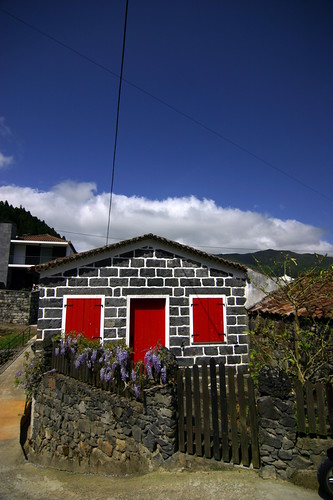Santa Cruz da Graciosa
Picturesque, while-washed town framed in foam and blue by the sea. Streets with manor-houses, many of them with but one storey, constituting an interesting group representative of rural architecture. At the centre of the town there are two large tanks, in times gone by used as water reservoirs for cattle, and a cluster of araucarias and elm-trees. Places to visit: Parish church; Church of Santo Cristo; Belfry; Cruz da Barra (cross) ; Chapels of Monte da Ajuda and the Ethnographic House.
Guadalupe
Typical, rural village, with white-washed houses set among flowers. The chapel of São Miguel Arcanjo (18th c.) is worthy of a visit. The Church of Nossa Senhora de Guadalupe. 18th c. building. Lively facade, in the baroque taste of the Azores. High and side altars. Glided, carved woodwork. Images.
Luz. White houses facing the sea, with the green heights of Caldeira in the background. The Church of Nossa Senhora da Luz. 17th c. building reconstructed in the 18th c. Ceiling of the chancel. High altar. Sculptured woodwork.
Praia
Old town streets and buildings recall its past importance. Picturesque fishing port. Opposite lies Praia islet, covered with vegetation and worth visiting by boat.
Vitória
Picturesque village.
The Graciosa panels
Masterpieces of Portuguese "primitive" painting of the 16th century. The artist is unknown, although they have been attributed to Cristóvão de Figueiredo. Five of the panels are on the theme of the Cross of Christ - the Way of the Cross, Erection of the Cross, Calvary, Invention of the Cross and Exaltation of the Cross - which suggests that they were specially ordered for the church of Santa Cruz, where they are to be found, The sixth panel, on Pentecost, shows the Virgin, the Apostles and the Holy Women receiving the light and fire of the Holy Ghost, which fits into the Azorean cult of the Holy Ghost, present since the start of settlement.
Picturesque, while-washed town framed in foam and blue by the sea. Streets with manor-houses, many of them with but one storey, constituting an interesting group representative of rural architecture. At the centre of the town there are two large tanks, in times gone by used as water reservoirs for cattle, and a cluster of araucarias and elm-trees. Places to visit: Parish church; Church of Santo Cristo; Belfry; Cruz da Barra (cross) ; Chapels of Monte da Ajuda and the Ethnographic House.
Guadalupe
Typical, rural village, with white-washed houses set among flowers. The chapel of São Miguel Arcanjo (18th c.) is worthy of a visit. The Church of Nossa Senhora de Guadalupe. 18th c. building. Lively facade, in the baroque taste of the Azores. High and side altars. Glided, carved woodwork. Images.
Luz. White houses facing the sea, with the green heights of Caldeira in the background. The Church of Nossa Senhora da Luz. 17th c. building reconstructed in the 18th c. Ceiling of the chancel. High altar. Sculptured woodwork.
Praia
Old town streets and buildings recall its past importance. Picturesque fishing port. Opposite lies Praia islet, covered with vegetation and worth visiting by boat.
Vitória
Picturesque village.
The Graciosa panels
Masterpieces of Portuguese "primitive" painting of the 16th century. The artist is unknown, although they have been attributed to Cristóvão de Figueiredo. Five of the panels are on the theme of the Cross of Christ - the Way of the Cross, Erection of the Cross, Calvary, Invention of the Cross and Exaltation of the Cross - which suggests that they were specially ordered for the church of Santa Cruz, where they are to be found, The sixth panel, on Pentecost, shows the Virgin, the Apostles and the Holy Women receiving the light and fire of the Holy Ghost, which fits into the Azorean cult of the Holy Ghost, present since the start of settlement.



No comments:
Post a Comment